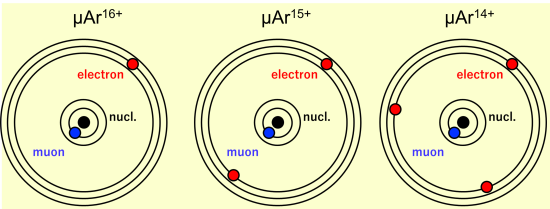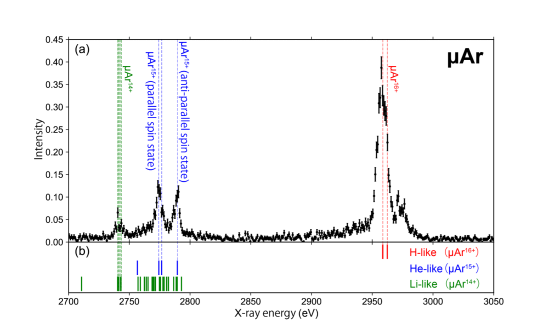June 19, 2025
Tokyo Metropolitan University
RIKEN
High Energy Accelerator Research Organization
National Institute for Fusion Science
Tohoku University
Rikkyo University
Chubu University
The University of Tokyo Kavli Institute for the Physics and Mathematics of the Universe (Kavli IPMU, WPI)
The University of Tsukuba
J-PARC

An international team of researchers, including members from the Kavli Institute for the Physics and Mathematics of the Universe (Kavli IPMU, WPI), has directly observed “highly charged muonic ions”, a completely new class of exotic atomic systems, in a gas-phase experiment for the first time. This groundbreaking study was selected as an Editors' Suggestion in Physical Review Letters, published online on June 16.
The observation highlights the capabilities of advanced superconducting transition-edge-sensor (TES) microcalorimeters in revealing previously inaccessible atomic phenomena.
Normal atoms consist of a nucleus and bound electrons and are electrically neutral. However, when many electrons are removed, the atom becomes highly charged. These charged atoms, known as highly charged ions, are valuable tools for research across various fields, including fundamental physics, nuclear fusion, surface science, and astronomy.
Researchers are particularly interested in plasmas—ionized gas consisting positive ions and electrons—found in high-energy environments such as the Sun and stars. Studying highly charged ions in plasma helps deepen our understanding of matter under extreme conditions. Although direct access to these environments is impossible, analyzing the characteristic x-rays emitted by highly charged ions provides insights into their structure and behavior.
The research team, led by Associate Professor Takuma Okumura from Tokyo Metropolitan University and Chief Scientist Toshiyuki Azuma from RIKEN and International Center for Quantum-field Measurement Systems for Studies of the Universe and Particles (QUP) at High Energy Accelerator Research Organization (KEK), focused on highly charged muonic ions, which contain negatively charged elementary particles called muons (Figure 1). The research team included collaborators from multiple institutions: Tadashi Hashimoto (RIKEN), Koichiro Shimomura (KEK), Daiji Kato (National Institute for Fusion Science), Yasushi Kino and Hirofumi Noda (Tohoku University), Shinya Yamada (Rikkyo University), Shinji Okada and Yuichi Toyama (Chubu University), Tadayuki Takahashi (Kavli IPMU), and Xiao-Min Tong (University of Tsukuba). Studying these ions could open novel research avenues.
Highly charged muonic ions are formed when a negative muon—a heavier cousin of the electron—is captured by an atom. During the muonic cascade, most of the bound electrons are ejected, leaving only one to a few in the atom. Although theoretical models predicted the existence of highly charged muonic ions, such as H-like, He-like, and Li-like configurations, they had never been experimentally observed due to their short lifetimes and the lack of sufficiently sensitive spectroscopic techniques.
Experiments were conducted at the D2 line of the Muon Science Experimental Facility (MUSE) of the Materials and Life Science Experimental Facility (MLF) at the Japan Proton Accelerator Research Complex (J-PARC) in Tokai-mura, Ibaraki. The MUSE is capable of producing the most intense low-energy muon beams in the world, enabling the generation of highly charged muonic ions. To detect these ions, the team improved their experimental setup.
They employed a superconducting transition-edge sensor (TES) microcalorimeter, an x-ray detector developed for high-precision spectroscopy, including cosmic x-ray observations. The TES is capable of measuring x-ray energies down to several keV with high energy resolution, making it ideal for identifying rare exotic atoms like highly charged muonic ions.
Using argon (Ar) atoms as targets, the measured x-ray spectra agreed with theoretical predictions (Figure 2). The peak observed on the high-energy side was emitted from a “H-like” highly charged muonic argon ion (μAr¹⁶⁺) with one bound electron, while three peaks on the low-energy side corresponded to characteristic x-rays emitted by “He-like” μAr¹⁵⁺ and “Li-like” μAr¹⁴⁺ ions with two or three bound electrons, respectively.
The successful observation of highly charged muonic ions demonstrates the effectiveness of the team’s methods and paves the way for expanded research into muonic atomic systems.

Paper details
Journal: Physical Review Letters
Paper title: Few-electron highly charged muonic Ar atoms verified by electronic K x rays
Authors: T. Okumura (1), T. Azuma (2), D. A. Bennett (3), W. B. Doriese (3), M. S. Durkin (4), J. W. Fowler (3), J. D. Gard (4), T. Hashimoto (5, 6), R. Hayakawa (7), Y. Ichinohe (6), P. Indelicato (8), T. Isobe (6), S. Kanda (9), D. Kato (10, 11), M. Katsuragawa (12), N. Kawamura (9), Y. Kino (13), N. Kominato (14), Y. Miyake (9), K. M. Morgan (3, 4), H. Noda (15), G. C. O’Neil (3), S. Okada (16, 10), K. Okutsu (13), N. Paul (8), C. D. Reintsema (3), T. Sato (17), D. R. Schmidt (3) K. Shimomura (9), P. Strasser (9), D. S. Swetz (3), T. Takahashi (12), S. Takeda (12), S. Takeshita (9), M. Tampo (9), H. Tatsuno (18) K. Tőkési (19), X. M. Tong (20), Y. Toyama (21), J. N. Ullom (3,4), S. Watanabe (22), S. Yamada (14) and T. Yamashita (13)
Author affiliations:
1 Department of Chemistry, Tokyo Metropolitan University, Hachioji, Tokyo 192-0397, Japan
2 Atomic, Molecular and Optical Physics Laboratory, RIKEN, Wako 351-0198, Japan
3 National Institute of Standards and Technology, Boulder, Colorado 80305, USA
4 Department of Physics, University of Colorado, Boulder, CO, 80309, USA
5 RIKEN Cluster for Pioneering Research, RIKEN, Wako, 351-0198, Japan
6 RIKEN Nishina Center, RIKEN, Wako 351-0198, Japan
7 International Center for Quantum-field Measurement Systems for Studies of the Universe and Particles (QUP), High Energy Accelerator Research Organization (KEK), Tsukuba, Ibaraki 305-0801, Japan
8 Laboratoire Kastler Brossel, Sorbonne Université, CNRS, ENS-PSL Research University, Collège de France, Case 74, 4, place Jussieu, 75005 Paris, France
9 High Energy Accelerator Research Organization (KEK), Tsukuba, Ibaraki 305-0801, Japan
10 National Institute for Fusion Science (NIFS), Toki, Gifu 509-5292, Japan
11 Interdisciplinary Graduate School of Engineering Sciences, Kyushu University, Fukuoka 816-8580, Japan
12 Kavli IPMU (WPI), The University of Tokyo, Kashiwa, Chiba 277-8583, Japan
13 Department of Chemistry, Tohoku University, Sendai, Miyagi 980-8578, Japan
14 Department of Physics, Rikkyo University, Tokyo 171-8501, Japan
15 Department of Astronomy, Tohoku University, Sendai, Miyagi 980-8578, Japan
16 Department of Mathematical and Physical Sciences, Chubu University, Kasugai, Aichi 487-8501, Japan
17 Department of Physics, Meiji University, Kawaski, Kanagawa 214-8571, Japan
18 Department of Physics, Tokyo Metropolitan University, Tokyo 192-0397, Japan
19 HUN-REN Institute for Nuclear Research (ATOMKI), 4026 Debrecen, Hungary
20 Center for Computational Sciences, University of Tsukuba, Tsukuba, Ibaraki 305-8573, Japan
21 Center for Muon Science and Technology, Chubu University, Kasugai, Aichi, 487-8501, Japan
22 Department of Space Astronomy and Astrophysics, Institute of Space and Astronautical Science (ISAS), Japan Aerospace Exploration Agency (JAXA), Sagamihara, Kanagawa 252-5210, Japan
DOI: 10.1103/PhysRevLett.134.
Paper abstract (Physical Review Letters)
Pre-print (arXiv.org)
Media contact
Motoko Kakubayashi
Press officer
Kavli Institute for the Physics and Mathematics of the Universe
The University of Tokyo
TEL: 04-7136-5980
E-mail:press_at_ipmu.jp
* Please change _at_ to @






